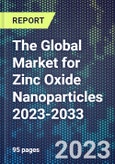1 RESEARCH METHODOLOGY
1.1 Report scope
1.2 Technology Readiness Level (TRL)
1.3 Market definition
1.3.1 Properties of nanomaterials
1.4 Categorization
2 EXECUTIVE SUMMARY
2.1 Market snapshot for zinc oxide nanoparticles
2.2 Markets and applications for zinc oxide nanoparticles
3 INTRODUCTION
3.1 Nanoparticle zinc oxide (Nano-ZnO)
3.1.1 Properties
3.1.1.1 Anti-bacterial properties
3.1.1.2 UV-resistance
5 MARKET SEGMENT ANALYSIS
5.1 COSMETICS AND SUNSCREENS
5.1.1 Market assessment
5.1.2 Global market in tons, historical and forecast to 2030
5.1.3 Producers
5.2 PAINTS AND COATINGS
5.2.1 Market assessment
5.2.2 Global market in tons, historical and forecast to 2030
5.2.3 Producers
6 OTHER MARKETS FOR ZINC OXIDE NANOPARTICLES
6.1 Biomedical and healthcare
6.2 Adhesives
6.3 Electronics
6.4 Sensors
6.5 Rubber and plastics
6.6 Textiles
8 REGULATIONS AND SAFETY
8.1 Europe
8.2 United States
8.3 Asia-Pacific
13 GLOBAL MARKET DEMAND FOR ZINC OXIDE NANOPARTICLES/POWDERS
13.1 Consumption in tons, 2010-2033
13.1.1 Total global consumption
13.1.2 Consumption by market 2019-2033
13.2 Consumption by region
LIST OF TABLES
Table 1. Technology Readiness Level (TRL) Examples.
Table 2. Categorization of nanomaterials.
Table 3. Market snapshot for zinc oxide nanoparticles-Selling grade particle diameter, usage, advantages, average price/ton, market estimates, global consumption, main current applications, future applications
Table 4. Markets and applications for zinc oxide nanoparticles.
Table 5. Physical properties of ZnO nanoparticles.
Table 6. Antibacterial effects of ZnO NPs in different bacterial species.
Table 7. Market assessment of nanoparticle TiO2 in cosmetics and sunscreens-market age, applications, key benefits and motivation for use, market megatrends, market drivers for use of nano-ZnO, technology drawbacks, main cosmetics and sunscreens producers globally.
Table 8. Global consumption of nanoparticle zinc oxide (tons) in cosmetics and sunscreens.
Table 9. Nanoparticle zinc oxide (tons) producers in cosmetics and sunscreens.
Table 10. Market assessment of nanoparticle TiO2 in coatings-market age, applications, key benefits and motivation for use, market megatrends, market drivers for use of nano-ZnO, technology drawbacks, main paints and coatings producers globally.
Table 11. Global consumption of nanoparticle zinc oxide (tons) in paints and coatings.
Table 12. Nanoparticle zinc oxide producers in coatings.
Table 13. Market assessment of nanoparticle zinc oxide in biomedical and healthcare-market age, applications, key benefits and motivation for use, market megatrends, market drivers for use of nano-ZnO, technology drawbacks.
Table 14. Market assessment of nanoparticle zinc oxide in adhesives- market age, applications, key benefits and motivation for use, market megatrends, market drivers for use of nano-ZnO, technology drawbacks.
Table 15. Market assessment of nanoparticle zinc oxide in electronics market age, applications, key benefits and motivation for use, market megatrends, market drivers for use of nano-ZnO, technology drawbacks.
Table 16. Market assessment of nanoparticle zinc oxide in sensors market age, applications, key benefits and motivation for use, market megatrends, market drivers for use of nano-ZnO, technology drawbacks.
Table 17. Market assessment of nanoparticle zinc oxide in rubber and plastics market age, applications, key benefits and motivation for use, market megatrends, market drivers for use of nano-ZnO, technology drawbacks.
Table 18. Market assessment of nanoparticle zinc oxide in textiles market age, applications, key benefits and motivation for use, market megatrends, market drivers for use of nano-ZnO, technology drawbacks.
Table 19. Zinc oxide nanoparticles market structure.
Table 20. Concentration limits (%) of nano-ZnO in sunscreens in main regional markets.
Table 21. Regulations and rulings related to nanoparticle zinc oxide in Europe.
Table 22. Regulations and rulings related to nanoparticle zinc oxide in North America.
Table 23. Regulations and rulings related to nanoparticle zinc oxide in Asia-Pacific.
Table 24. Nanoparticle zinc oxide SWOT analysis.
Table 25. Example prices of zinc oxide nanoparticles/powders.
Table 26. Main Zinc oxide nanoparticles-Suppliers, products, primary particle size.
Table 27. Global consumption of zinc oxide nanoparticles (tons), 2010-2033.
Table 28. Consumption of Zinc oxide nanoparticles/powders, by market 2020-2033 (tons), conservative estimate.
Table 29. Production estimates by company, low and high estimates.
Table 30. Target market for Nano-ZnO products, by main suppliers.
Table 31. Other producers of zinc oxide nanoparticles.
LIST OF FIGURES
Figure 1. Different structures of ZnO.
Figure 2. Schematic of antibacterial activity of ZnO NPs.
Figure 3. Techniques used for ZnO nanoparticles synthesis.
Figure 4. Global consumption of nanoparticle zinc oxide (tons) in cosmetics and sunscreens.
Figure 5. Global consumption of nanoparticle zinc oxide (tons) in paints and coatings.
Figure 6. TRL for zinc oxide nanoparticles/powders.
Figure 7. Zinc oxide nanoparticles/powders market share 2022 (%)
Figure 8. Zinc oxide nanoparticles/powders market share 2022 (tons), conservative estimate.
Figure 9. Consumption of zinc oxide nanoparticles (tons), by market, 2010-2033.
Figure 10. Consumption of Zinc oxide nanoparticles/powders, by market 2020-2033 (tons), conservative estimate.
Figure 11. Consumption of zinc oxide nanoparticles/powders, by region 2020 (%).
Figure 12. Consumption of zinc oxide nanoparticles/powders, by region 2020 (tons).









